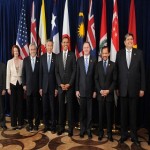If the U.S. Congress passes legislation to fast-track the Trans-Pacific Partnership (TPP), as has been reported this week, the 12-nation trade deal might soon be concluded.
Meanwhile, the Regional Comprehensive Economic Partnership Agreement (RCEP), which involves the 10 ASEAN countries plus Australia, China, India, Japan, Korea, and New Zealand, remains on slow-track.
While the payoffs from these two regional trade discussions will be evident only in the decades ahead, they may well represent the fable of the tortoise and the hare—the slow-moving RCEP “tortoise” wins the race against the over-confident TPP “hare” with its quick-win strategy.
The TPP has been presented by the U.S. government as a comprehensive and high-quality regional agreement. Some observers suggest that it could be a catalyst for broader agreements, perhaps even a multilateral understanding. An analogy is drawn with NAFTA (the North American Free Trade Agreement) and the creation of APEC (Asia-Pacific Economic Cooperation), which were seen as helping to conclude the Uruguay Round when it reached a deadlock in the early 1990s. More generally, the TPP addresses “Doha plus”—or “behind-the-border”—regulatory issues that can shape future multilateral rounds.
But the TPP, its ambitious agenda notwithstanding, is a traditional trade agreement based on a single-undertaking (or package) negotiation. It has a pre-defined agenda and works to a timetable for a final deal. In doing this, the TPP uses a model that is past its “use-by” date.
The model is, of course, the familiar trade agreement template inherited from the multilateral system. But the multilateral experience does not inspire confidence in the TPP’s longer-term relevance. Traditional trade agreements can make gains, but they fail to capture the dynamic nature of the global economy and its trade and investment. The TPP’s “agreed and done” approach misses the opportunities that will shape trade and investment in the next decade and beyond.
Since the Doha Round of trade negotiations was launched among members of the World Trade Organisation (WTO) in 2001, global trade and investment have already been transformed. Global value chains have become fundamental to trade and investment, especially in Asia. South-South trade is now as important as the long-standing North-South trade patterns, and the global economy has become multipolar, with the major emerging economies as the new poles of global growth. Doha’s focus on inequality from a North-South perspective does not have the same logic in this world.
On the other hand, the RCEP is based on a very different idea—that a 21st century trade and investment agreement needs a robust and updated framework. The framework needs to tackle not only the current agenda of trade in goods and services but, over time, it must be able to take up yet-to-be-defined trade and investment issues that will inevitably emerge. Recent examples of such unanticipated issues are national regulations requiring data to be stored and analysed locally, and legal barriers impeding the cross-border flow of data. The RCEP enables its participating members to tackle such issues as they arise.
The RCEP was drafted using the norms of open accession, transparency, and best standards. It specifies that agreements will be consistent with WTO principles. It also provides a mechanism for consolidating the six agreements that dialogue partners have with ASEAN by ensuring that it is a “ratcheting-up” process toward the best practices of all the six agreements with Australia, China, India, Japan, Korea, and New Zealand.
While a TPP might offer deeper upfront integration, it is less clear that it offers a long-term path for Asian economies—and this argument applies to those in the TPP negotiations as well as to those outside. The failure of the TPP to recognise development challenges will persist as a problem for countries outside of the TPP. It offers a binary choice—countries either meet the high-standards of the TPP or they do not. In contrast, the RCEP explicitly tackles capacity-building and has the scope for phased adjustment, recognising the significant diversity of the stages of development within ASEAN and across its partners.
The TPP also brings challenges for its emerging market members. By moving beyond a conventionally-defined trade liberalisation agenda, the TPP can trigger tensions that may turn out to be inimical to trade and development. For example, in the domain of intellectual property rights (IPR)—while technology transfer is decisive for development, stringent IPR rules that meet U.S. interests can be an impediment to, rather than supportive of, trade.
“Behind-the-border” regulatory issues that increasingly shape global trading relationships are also a source of potential tension. The push in the TPP for extending this agenda to include topics such as labour and environment, and a one-size-fits all agreement on these issues, does not allow for national priorities and developmental differences. Countries may well share aspirations for labour and environment, but it does not mean that the standards and national approaches on these issues are shared.
While a TPP might seemingly offer deeper upfront integration compared to the RCEP’s regional ambit, it is the RCEP’s design that reflects a best practices approach for a desirable global or multilateral system. It is the RCEP, rather than TPP, that can aspire to be a model for a new global rules-based framework.
David Nellor is adjunct professor, Lee Kuan Yew School of Public Policy, National University of Singapore. He was a consultant to the Indonesian Minister of Trade in preparing the RCEP.
This article was exclusively written for Gateway House: Indian Council on Global Relations. You can read more exclusive content here.
For interview requests with the author, or for permission to republish, please contact outreach@gatewayhouse.in.
© Copyright 2015 Gateway House: Indian Council on Global Relations. All rights reserved. Any unauthorized copying or reproduction is strictly prohibited


